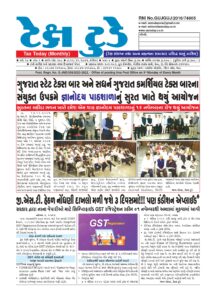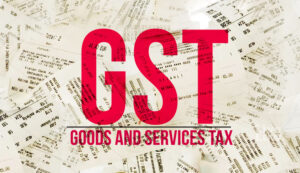GST WEEKLY UPDATE : 27/2022-23 (02.10.2022) By CA Vipul Khandhar

By Vipul Khandhar
- GST on Export Freight:
- The GST exemption on export Freight was valid until 30th September 2018, and was further extended till 30th September 2022 but with no further extension effective from 1st October 2022, the following transactions would be taxable under GST –
- – Ocean export freight billed to customers in India to be charged at the *GST rate of 5%.
- – Air export freight billed to customers in India to be charged at the GST rate of 18%
- Under Section 12(8) of the IGST Act, since there have been no further extensions in exemption, the GST shall be charged on all outbound freight transactions when billed to Indian customers considering the place of supply as 97 (i.e. Other Territory) w.e.f. 1st October 2022.
- GST rules Amendments enacted by Finance Act 2022 become effective from 01.10.2022:
(A) Restrictions imposed for availing ITC- New clause (ba) inserted in Sec 16(2) – Additional condition for claiming ITC by buyer that ITC can be claimed only if that ITC has not been restricted in auto generated statement -GSTR-2B u/s 38 of CGST ACT.
- So ITC which cannot be availed such as-
- Related to suppliers who have taken new registration for such period as may be prescribed.
- Related to suppliers who have defaulted in payment of tax and default continues for such period as may be prescribed.
- Related to suppliers who have declared output tax liability more in GSTR-1 but paid tax less in GSTR-3B.
- ITC claimed more than ITC auto-populated in GSTR-2B
- ITC claimed in violation of conditions prescribed in Section 49 (12)- Maximum proportion of output tax liability which may discharged through electronic credit ledger.
(B) Time period extended for claiming ITC related to previous financial year- Section 16(4) amended to provide that time limit for claiming ITC in respect of Invoices related to previous financial year now extended upto 30th November of following financial year. This amendment also applicable for F.Y 2021-22.
(C) Time period for Cancellation of registration –
- In case of composite taxpayers – Section 29 (2) (b) amended now registration of composite taxpayer will be cancelled if he fails to furnish return for a financial year beyond 3 months from due date.
- In case of regular taxpayers- Registration will be cancelled if he fails to furnish return for such continuous period as may be prescribed. (presently 6 months)
- In case of registered person under QRMP scheme -registration will be cancelled if not furnished returns for continuous two tax periods.
(D) Extension of time limit for issuing credit note -Section 34 of CGST ACT- Now time limit for issuing credit note now extended up to 30th Nov of following financial year.
(E) Amendment in Section 37- Return of outward supply- Now amendment in Section 37 also made regarding rectification of errors related to previous year up to 30th November of following financial year.
(F) Other Misc:
- Now it is mandatory to file sequential returns.
- Refund of any balance in cash ledger – Now registered person can claim any balance in Cash ledger in such form and manner as may be prescribed.
- Levy of late fees for not filling GSTR-8 with in due date -Rs 100 per day subject to maximum of Rs.5000/-.
- Transfer any amount of tax, interest and penalty or any other amount available in electronic cash ledger to IGST /CGST of a distinct person as specified in sec 25(4) or Sec 25(5) in such form and manner subject to such conditions and restrictions as may be prescribed and such transfer shall be deemed to be refund from cash ledger.
- Registration can be cancelled if rule 86B not compiled with i.e compulsory payment of 1 % output tax liability in cash. (Section 49 (12) notified).
- Advisory on Filing TRAN-1/2 Forms to claim Transitional Credit w.e.f 01/10/2022:
- The Hon’ble Supreme Court of India has provided a one-time opportunity to all the aggrieved taxpayers to file Form TRAN-1/TRAN-2 and claim their transitional input tax credit in GST system. In compliance of the Hon’ble court’s directive, the facility for filing TRAN-1/ TRAN-2 or revising the earlier filed TRAN-1/TRAN-2 on the GST common portal by aggrieved taxpayers have been made available by GSTN from 10.2022, and as per the court’s instruction shall be available to all aggrieved taxpayers till 30.11.2022.
- The TRAN filing process has been enhanced and the user interface of the portal has been made more intuitive to make it simple and easy for the taxpayer to file their forms TRAN-1/2. For smooth and easy filing of TRAN-1/2 a detailed advisory and a step by step, frame by frame guide has also been prepared. Please click herefor the detailed advisory and help manuals.
It is also advised to please download the advisory and follow all the important points mentioned therein for an easy return filing experience.
- Points to be Noted:-
- In compliance of the Supreme Court‟s directive, the TRAN forms are enabled and the default filing status of TRAN forms for all taxpayers is now visible as “Not Filed”. The status “Not Filed” only implies that TRAN forms are not filed in the new window provided by the Hon‟ble court during 01.10.2022 to 30.11.2022.
- It is therefore clarified that those registered persons, who had successfully filed TRAN-1/TRAN-2 earlier, and who do not require to make any revision in the same, are not required to file/ revise TRAN-1/TRAN-2 again during this period from 01.10.2022 to 30.11.2022.
- The option of filing or revising TRAN-1/TRAN-2 on the common portal during the period from 01.10.2022 to 30.11.2022 is a one-time opportunity for the applicant to either file the said forms, if not filed earlier, or to revise the forms filed earlier.
- Input Tax Credit shall reflect in the Credit ledger of the taxpayer post verification by the jurisdictional tax-officer.
- Access / Navigation to file TRAN-1 / TRAN – 2 Forms: How to access TRAN form:
- Access the www.gst.gov.in. The GST Home page is displayed.
- Login to the GST Portal with valid credentials.
- Click the Services > Returns > Transition Forms command.
- Guidelines for filing of GST TRAN-1 Attention of the taxpayers is drawn to follow the below-mentioned guidelines:
The taxpayer can navigate to TRAN-1 forms post login by navigating to Services > Returns > Transition Forms. The Transition Forms page is then displayed.
- On the landing page the taxpayer would be provided with three tabs on the top band for TRAN – 1, TRAN -2 and Upload Documents respectively. The tile of Form TRAN – 1 will be visible by default.
- For the question Whether all the returns required under existing law for the period of six months immediately preceding the appointed date have been furnished, select the Yes or No option as the case may be.
The taxpayers are advised to carefully select an option as this is a very important step. If ‘Yes’ is selected then the all tables of TRAN-1 shall be open for the taxpayers to fill in with the respective details. However, if the taxpayers select ‘No’, then the system would not allow the taxpayers to fill details in Table 5 and Table 8 of TRAN-1 and these tables would be hidden from the taxpayers.
- Caution: The taxpayers should ensure that there are no saved records in Table 5 & Table 8 of TRAN-1 forms before selecting “No” option. Selecting an option of Yes / No contradicting to the data filed / not filed in Table 5 and 8 of TRAN-1 respectively may result in denial of credit by the officer examining the details of the form filled.
In case the records to be added in table 6(a), 6(b), 7(a) and 7(b) are substantial, the taxpayer can prepare the details offline by using the ‘Excel template’ and create the JSON file and upload it in respective tables.
In case the records to be added in table 5(b), 9(a) and 9(b) are substantial, the taxpayer can prepare the details offline by using the ‘CSV template’ and upload the CSV file in respective tables.
In case, the records are not substantial and the taxpayers choose to file the form online, then they shall add the details in the required tables and click the Save button on each table to save the added records.
The records which are added in table 5(b), 6(a), 6(b), 7(a), 7(b), 9(a) and 9(b) by using the JSON or CSV or online facility can also be downloaded by clicking a download button provided on the page. The taxpayers are advised to download the uploaded records and verify the same. This would ensure that correct records are added/ uploaded. Form should be submitted thereafter only.
Here it is pertinent to mention that taxpayers may find some records missing in downloaded Excel as compared to uploaded CSV, this may happen because of the reason that taxpayer may have uploaded an incorrect/incomplete CSV file while uploading. Therefore in such cases taxpayer is advised to enter data in mandatory fields in CSV and upload it again.
The taxpayer can also download the complete TRAN-1 details added by them by clicking on button „DOWNLOAD TRAN-1 DETAILS’. Taxpayers are hereby advised again to download the filled TRAN form in Excel file and verify the details before finally submitting Form TRAN-1.
As already stated earlier; the taxpayers must file the TRAN-1 form by clicking the „File with DSC‟ or „File with EVC‟ button after clicking the „Submit‟ button for submitting the TRAN-1 form.
Once TRAN-1 is Filed successfully, it cannot be revised. Taxpayer should verify details furnished by them before clicking on Submit button.
- Precautions to be taken during TRAN-1/TRAN-2 filing:
The applicant is required to take utmost care and precaution while filing or revising TRAN 1/TRAN-2 and thoroughly check the details before filing his claim on the common portal. The taxpayers are advised to save the details periodically, download the added details and cross verify downloaded data with the added records/uploads, before submitting the forms.
In case a taxpayer has already filed his original TRAN and wants to revise his/her earlier filed TRAN, the taxpayer is requested to file the complete form with all the required details and not the differential values (i.e. the difference between originally claimed credit and credit being claimed now). The taxpayers are also provided with a preview functionality wherein they can download the currently filled TRAN forms in Excel format and ensure the correctness of the details filled by them before finally submitting the form.
The taxpayers are advised to save the added records using “Save” button on each table before navigating to other tables. At this stage, modifying and editing records is feasible.
The taxpayers are allowed to modify/edit, add or delete any record in any of the table of the said forms before clicking the “Submit” button. Once “Submit” button is clicked, the entries from the form gets locked, and no further editing of details would be allowed.
This locked form would then be required to be mandatorily filed on the portal using “File with DSC” or “File with EVC” button using Digital signature certificate (DSC) or an EVC.
It is pertinent to note that if the submitted forms are not filed with DSC or EVC then the submitted forms would be considered as Not Filed as it would be an unsigned form.
To facilitate the taxpayers further, the DOWNLOAD EARLIER FILED TRAN-1 forms functionality will also be made available shortly
- GST TRAN-2 How to Navigate:
The taxpayer can navigate to TRAN-2 post logging into the Common portal by navigating to Services > Returns > Transition Forms > TRAN-2. Points to note:
- The taxpayer shall file the entire claim in one consolidated FORM GST TRAN-2, instead of filing the claim tax period wise as referred to in sub-clause (iii) of clause (b) of sub-rule (4) of rule 117 of the Central Goods and Services Tax Rules, 2017. In the column “Tax Period” in FORM GST TRAN-2, the taxpayer shall mention the last month of the consolidated period for which the claim is being made.
- TRAN-2 form shall be made available only if the taxpayer has filed TRAN-1 and have made declaration in table 7 of TRAN-1. The taxpayer is requested to fill the complete details afresh in case they are revising the earlier filed TRAN-2 Form.
- In case the records to be added in table 4 and 5 are substantial, the taxpayer can prepare the details offline by using the „Excel template‟ and create the JSON file and upload it in respective table.
- The records which are added in table 4 and 5 by using the JSON file or online can be downloaded in CSV file for ensuring that all the records are added and for its correctness.
- In case, the records are not substantial and the taxpayers choose to file it online, then they shall add the details in the required tables and click the Save button on each table to save the added records.
- The taxpayer can also download the complete TRAN-2 details added by them by clicking on button „DOWNLOAD TRAN-2 DETAILS‟. It is advisable that the taxpayer downloads the Excel file to verify the details before finally submitting the same.
- Taxpayer must ensure correctness of the form before clicking on submit button, once the taxpayer has clicked on Submit button, they shall not be allowed to edit the form.
- The taxpayers, who have filed TRAN-2 earlier, can download the earlier filed TRAN-2 form by clicking on DOWNLOAD EARLIER FILED TRAN-2 button.
- Taxpayers must file the TRAN-2 form after clicking the Submit button by EVC or DSC. The forms will be sent to jurisdictional tax officers only on successful filing of TRAN-2 form.
- Once TRAN-2 is Filed it cannot be revised. Taxpayer to ensure every detail furnished by them is correct before clicking on Submit form.
UPLOAD DOCUMENTS A separate facility to upload any supporting documents in GST transition is also provided to the taxpayers after filing the TRAN forms in the “Upload Documents” tab. The taxpayer can navigate post logging into the Common portal and navigating to Services > Returns > Transition Forms > Upload documents.
- Taxpayers are allowed to upload a maximum of four PDF documents of 5 MB each.
- Taxpayers are required to click submit button once all the required document is uploaded. Once the details are submitted, no further changes can be made. Taxpayer to ensure every document furnished by them is correct before clicking on Submit as they would be used by the officers to verify the ITC claim.
- Declaration revision if any & verification by the department:
The declaration in FORM GST TRAN-1/TRAN-2 filed/revised by the applicant will be subjected to necessary verification by the concerned tax officers. The applicant may be required to produce the requisite documents/ records/ returns/ invoices in support of their claim of transitional credit before the concerned tax officers for verification of their claim. After the verification of the claim, the jurisdictional tax officer will pass an appropriate order thereon on merits after granting appropriate reasonable opportunity of being heard to the applicant. The transitional credit allowed as per the order passed by the jurisdictional tax officer will be reflected in the Electronic Credit Ledger of the applicant on the GST common portal.
- FTP policy validity extended up to 31.03.2023.
The existing Foreign Trade Policy 2015-2020 which is valid upto 30.09.2022 is extended upto 31st March, 2023 by DGFT.
Disclaimer:
This publication contains information for general guidance only. It is not intended to address the circumstances of any particular individual or entity. Although the best of endeavour has been made to provide the provisions in a simpler and accurate form, there is no substitute to detailed research with regard to the specific situation of a particular individual or entity. We do not accept any responsibility for loss incurred by any person for acting or refraining to act as a result of any matter in this publication.
(Author is a well known Chartered Accountant practicing in the field of Direct and Indirect Taxes)





